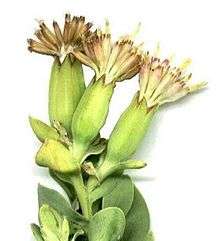Senecioneae
Senecioneae is the largest tribe of the Asteraceae, or the sunflower family, comprising about 150 genera and 3,000 species. Almost one-third of the species in this tribe are placed in the genus Senecio.[1] Its members exhibit probably the widest possible range of form to be found in the entire plant kingdom, and include annuals, minute creeping alpines, perennial herbs, shrubs, climbers, succulents, trees, and semiaquatic plants.[2]
| Senecioneae | |
|---|---|
 | |
| Lopholaena coriifolia | |
| Scientific classification | |
| Kingdom: | Plantae |
| Clade: | Tracheophytes |
| Clade: | Angiosperms |
| Clade: | Eudicots |
| Clade: | Asterids |
| Order: | Asterales |
| Family: | Asteraceae |
| Subfamily: | Asteroideae |
| Supertribe: | Senecionodae |
| Tribe: | Senecioneae Cass. |
| Genera | |
|
See text | |
Plants in this tribe are responsible for more livestock poisonings than all other plants combined.[3] The poisons are particularly pyrrolizidine alkaloids in Senecio[3] and furanoeremophilanes in Tetradymia.[4]
A number of species are well known in horticulture.[2]
Classification
Since the time of Bentham, the "premier systematic botanist of the nineteenth century"[5] considerable efforts have been made to classify and understand the striking morphological diversity in the Senecioneae.[1] The traditional view of the tribe has been that of one huge genus Senecio plus many other genera which exhibit varying degrees of distinctiveness.[5] Circumscription and delimitation of the tribe have experienced expansions and contractions over the decades as genera and groups of genera have been moved in and out,[2] as was the case for Arnica, Liabum, Munnozia, Schistocarpha, etc. which have since then been excluded.[5] Of the several potential causes for this constant redefinition the greatest is probably that little is known about its intergeneric relationships or a lack of phylogenetic understanding enhanced by the other problems of conflicting clues from morphological characters, the large size of the tribe, the absence of a precise delimitation or circumscription of Senecio[1] and the naturalness of these assemblages combined with the imprecise boundaries of the different species themselves.[5]
Many segregate genera have been recognized in recent studies, often with circumscriptions derived from selected representative species. Whether the recognition of numerous segregate genera provides a better taxonomy than treating the variation patterns as infrageneric taxa is yet unclear. A respectable case can be made for maintaining Senecio as a broad concept, at least until revisionary studies at the species level are carried out and the results subjected to critical analyses.[5] Most genera that have been removed from the Senecioneae in the broadest sense have come to rest within the Liabeae or within a broadly circumscribed Heliantheae (e.g., allies in the Arnicinae, Chaenactidinae, or Madiinae; Haploësthes in the Flaveriinae; and Raillardella and allies in the Madiinae). Additional information may be found in B. G. Baldwin et al. (2002), H. Robinson (1981), B. Nordenstam (1977–1978) and K. Bremer (1994).[2]
Genera
Selection of genera compiled from several lists:[2][6]
- Abrotanella
- Acrisione
- Adenostyles
- Aequatorium
- Antillanthus
- Arnoglossum
- Barkleyanthus
- Bedfordia
- Bethencourtia
- Blennosperma
- Brachyglottis
- Cacaliopsis
- Capelio
- Caucasalia
- Caxamarca
- Chersodoma
- Cineraria
- Cissampelopsis
- Crassocephalum
- Crocidium
- Cremanthodium
- Delairea
- Dendrophorbium
- Dicerococlados
- Dolichorrhiza
- Dolichoglottis
- Dorobaea
- Doronicum
- Elekmania
- Emilia
- Erechtites
- Euryops
- Farfugium
- Gymnodiscus
- Gynura
- Gynoxys
- Haastia
- Hasteola
- Hertia
- Homogyne
- Iranecio
- Jacobaea
- Jessea
- Kleinia
- Lachanodes
- Lamprocephalus
- Lasiocephalus
- Lepidospartum
- Ligularia
- Ligulariopsis
- Lopholaena
- Luina
- Mikaniopsis
- Misbrookia
- Nemosenecio
- Oligothrix
- Oresbia
- Othonna
- Packera
- Paracalia
- Parasenecio
- Pericallis
- Petasites
- Phaneroglossa
- Pittocaulon
- Pladaroxylon
- Pojarkovia
- Psacalium
- Pseudogynoxys
- Rainiera
- Roldana
- Rugelia
- Senecio
- Sinacalia
- Sinosenecio
- Solanecio
- Steirodiscus
- Stilpnogyne
- Syneilesis
- Synotis
- Talamancalia
- Tephroseris
- Tetradymia
- Traversia
- Tussilago
- Werneria
- Xenophyllum
- Yermo
References
- Pelser, Pieter B; Nordenstam, Bertil; Kadereit, Joachim W.; Watson, Linda E. (November 2007). "An ITS phylogeny of tribe Senecioneae (Asteraceae) and a new delimitation of Senecio L.". Taxon. International Association for Plant Taxonomy (IAPT). 56 (4): 1077–14E(–1062). doi:10.2307/25065905. JSTOR 25065905.
- Flora of North America. "Senecioneae". Family List. 20: 540. Retrieved 2008-04-14.
- Pieter B. Pelser, Barbara Gravendeel and Ruud van der Meijden (2002). "Tackling speciose genera: species composition and phylogenetic position of Senecio sect. Jacobaea (Asteraceae) based onplastid and nrDNA sequences". American Journal of Botany. 89 (6): 929–939. doi:10.3732/ajb.89.6.929. PMID 21665692.
- "Senecioneae". Flora of North America.
- Barkley, T. M. (February 1985). "Generic Boundaries in the Senecioneae". Taxon. International Association for Plant Taxonomy (IAPT). 34 (1): 17–21. doi:10.2307/1221558. JSTOR 1221558.
- Botanic Garden and Botanical Museum Berlin-Dahlem. "Details for: Senecioneae". Euro+Med PlantBase. Freie Universität Berlin. Retrieved 2008-04-14.
External links
![]()
![]()